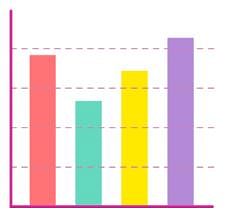Class 6 Exam > Class 6 Tests > Mathematics (Maths) Class 6 > Test: Data Handling and Presentation - 1 - Class 6 MCQ
Test: Data Handling and Presentation - 1 - Class 6 MCQ
Test Description
10 Questions MCQ Test Mathematics (Maths) Class 6 - Test: Data Handling and Presentation - 1
Test: Data Handling and Presentation - 1 for Class 6 2024 is part of Mathematics (Maths) Class 6 preparation. The Test: Data Handling and Presentation - 1 questions and answers have been
prepared according to the Class 6 exam syllabus.The Test: Data Handling and Presentation - 1 MCQs are made for Class 6 2024 Exam. Find important
definitions, questions, notes, meanings, examples, exercises, MCQs and online tests for Test: Data Handling and Presentation - 1 below.
Solutions of Test: Data Handling and Presentation - 1 questions in English are available as part of our Mathematics (Maths) Class 6 for Class 6 & Test: Data Handling and Presentation - 1 solutions in
Hindi for Mathematics (Maths) Class 6 course. Download more important topics, notes, lectures and mock
test series for Class 6 Exam by signing up for free. Attempt Test: Data Handling and Presentation - 1 | 10 questions in 10 minutes | Mock test for Class 6 preparation | Free important questions MCQ to study Mathematics (Maths) Class 6 for Class 6 Exam | Download free PDF with solutions
Test: Data Handling and Presentation - 1 - Question 1
Navya collected data on the favorite games of her classmates and found that 8 students prefer cricket, 5 prefer hockey, and 3 prefer football. What type of chart would best represent this data visually?
Detailed Solution for Test: Data Handling and Presentation - 1 - Question 1
Test: Data Handling and Presentation - 1 - Question 2
If a pictograph uses one symbol to represent 5 students, how many symbols would represent 25 students?
Detailed Solution for Test: Data Handling and Presentation - 1 - Question 2
| 1 Crore+ students have signed up on EduRev. Have you? Download the App |
Test: Data Handling and Presentation - 1 - Question 3
In a bar graph showing the number of students absent in different classes, if the bar for Class 5 reaches up to 6 on the vertical axis, how many students were absent in Class 5?
Detailed Solution for Test: Data Handling and Presentation - 1 - Question 3
Test: Data Handling and Presentation - 1 - Question 4
If a class of 30 students is represented in a pie chart and one section of the chart shows 10 students liking football, what angle does the football section represent?
Detailed Solution for Test: Data Handling and Presentation - 1 - Question 4
Test: Data Handling and Presentation - 1 - Question 5
You roll a die 30 times and record the outcomes. If the number '3' appears 5 times, what is the frequency of '3'?
Detailed Solution for Test: Data Handling and Presentation - 1 - Question 5
Test: Data Handling and Presentation - 1 - Question 6
If a bar graph shows the number of books borrowed from a library during the week, and Friday has the longest bar, what does this imply?
Detailed Solution for Test: Data Handling and Presentation - 1 - Question 6
Test: Data Handling and Presentation - 1 - Question 7
In a survey, students' preferences for after-school activities were recorded. If 40% of students preferred sports, what type of graph would best display this data?
Detailed Solution for Test: Data Handling and Presentation - 1 - Question 7
Test: Data Handling and Presentation - 1 - Question 8
A bar graph shows the number of candies sold in a week, with Monday showing the lowest bar. What does this indicate?
Detailed Solution for Test: Data Handling and Presentation - 1 - Question 8
Test: Data Handling and Presentation - 1 - Question 9
In a pictograph, each symbol represents 4 apples. If there are 3 symbols next to Tuesday, how many apples were sold on Tuesday?
Detailed Solution for Test: Data Handling and Presentation - 1 - Question 9
Test: Data Handling and Presentation - 1 - Question 10
In a class survey, students were asked their favorite fruits. If you want to predict which fruit will have the highest bar in a bar graph, which type of data should you consider?
Detailed Solution for Test: Data Handling and Presentation - 1 - Question 10
|
94 videos|347 docs|54 tests
|
Information about Test: Data Handling and Presentation - 1 Page
In this test you can find the Exam questions for Test: Data Handling and Presentation - 1 solved & explained in the simplest way possible.
Besides giving Questions and answers for Test: Data Handling and Presentation - 1, EduRev gives you an ample number of Online tests for practice
|
94 videos|347 docs|54 tests
|
Download as PDF

















